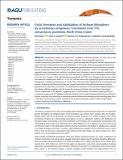Files in this item
Cyclic formation and stabilization of Archean lithosphere by accretionary orogenesis : constraints from TTG and potassic granitoids, North China Craton
Item metadata
| dc.contributor.author | Wang, Wei | |
| dc.contributor.author | Cawood, Peter A. | |
| dc.contributor.author | Liu, Shuwen | |
| dc.contributor.author | Guo, Rongrong | |
| dc.contributor.author | Bai, Xiang | |
| dc.contributor.author | Wang, Kang | |
| dc.date.accessioned | 2018-03-07T00:33:10Z | |
| dc.date.available | 2018-03-07T00:33:10Z | |
| dc.date.issued | 2017-09 | |
| dc.identifier | 250595784 | |
| dc.identifier | 571ccceb-75ee-4fd2-8f25-c6e0ff9aad6e | |
| dc.identifier | 85028916001 | |
| dc.identifier | 000413492300004 | |
| dc.identifier.citation | Wang , W , Cawood , P A , Liu , S , Guo , R , Bai , X & Wang , K 2017 , ' Cyclic formation and stabilization of Archean lithosphere by accretionary orogenesis : constraints from TTG and potassic granitoids, North China Craton ' , Tectonics , vol. 36 , no. 9 , pp. 1724-1742 . https://doi.org/10.1002/2017TC004600 | en |
| dc.identifier.issn | 1944-9194 | |
| dc.identifier.other | Bibtex: urn:1c51abd50d4d2ecb2a1be374b015d5f6 | |
| dc.identifier.uri | https://hdl.handle.net/10023/12866 | |
| dc.description | This study is financially supported by the National Natural Science Foundation of China (Grant Nos. 41502179, 41530207, 41472165) and Central University Basic Scientific Research Business Expenses of China University of Geosciences (Beijing) (Grant No. 2652015038). PAC acknowledges support from Australian Research Council grant FL160100168. | en |
| dc.description.abstract | Accretionary orogens are major sites of modern continental growth, yet their role in the development of Archean continental crust remains enigmatic. Diverse granitoid suites from tonalite-trondhjemite-granodiorite (TTG) to potassic granitoids appeared during late Archean, representing a period of major continental formation and stabilization. In this study, whole-rock geochemical and zircon U-Pb and Lu-Hf isotopic data are reported for Neoarchean granitoid gneisses from the Northern Liaoning Terrane, northeastern North China Craton (NCC). Older granitoid gneisses (~2592-2537 Ma) define three magmatic zones migrating from southeast to northwest, each showing a common magmatic evolution from high-pressure TTGs to medium-/low-pressure TTGs and potassic granitoids. They have depleted zircon ƐHf(t) of +0.5 to +8.7. Younger ~2529-2503 Ma potassic granitoids and TTGs occur throughout the terrane, which are marked by variable zircon ƐHf(t) of -4.7 to +8.1, and are coeval with regional high grade metamorphism. Petrogenetic modeling and changing Sr/Y and (La/Yb)N of the granitoids suggest that the crust experienced episodic thickening and thinning, and became progressively evolved through development of potassic granitoids and sedimentary successions. The metavolcanic basement to the granitoids display tholeiitic to calc-alkaline affinities, together with the top-to-the-northwest thrusting and associated VMS-type Cu-Zn deposits, suggesting cyclic crustal formation of Northern Liaoning within an accretionary orogen with a SE-dipping subduction polarity. Cyclic crustal thickening and thinning is related to tectonic switching from advancing to retreating relations between the downgoing and overriding plate. After ~2530 Ma, this accretionary system accreted to the ancient continental nucleus of NCC (Anshan-Benxi Terrane), signifying final lithosphere stabilization. | |
| dc.format.extent | 3663242 | |
| dc.language.iso | eng | |
| dc.relation.ispartof | Tectonics | en |
| dc.subject | Neoarchean | en |
| dc.subject | TTG and potassic granitoid gneisses | en |
| dc.subject | Northern Liaoning Terrane | en |
| dc.subject | North China Craton | en |
| dc.subject | Cyclic lithosphere formation and stablization | en |
| dc.subject | Accretionary orogen | en |
| dc.subject | GE Environmental Sciences | en |
| dc.subject | QE Geology | en |
| dc.subject | NDAS | en |
| dc.subject.lcc | GE | en |
| dc.subject.lcc | QE | en |
| dc.title | Cyclic formation and stabilization of Archean lithosphere by accretionary orogenesis : constraints from TTG and potassic granitoids, North China Craton | en |
| dc.type | Journal article | en |
| dc.contributor.institution | University of St Andrews. School of Earth & Environmental Sciences | en |
| dc.contributor.institution | University of St Andrews. School of Geography and Geosciences | en |
| dc.contributor.institution | University of St Andrews. Scottish Oceans Institute | en |
| dc.contributor.institution | University of St Andrews. St Andrews Isotope Geochemistry | en |
| dc.identifier.doi | 10.1002/2017TC004600 | |
| dc.description.status | Peer reviewed | en |
| dc.date.embargoedUntil | 2018-03-06 |
This item appears in the following Collection(s)
Items in the St Andrews Research Repository are protected by copyright, with all rights reserved, unless otherwise indicated.

